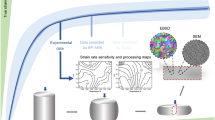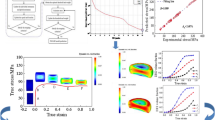Abstract
A series of hot compression tests were conducted in the temperature range of 800-1100 °C under the strain rates of 0.001, 0.01, and 0.1 s−1 to assess the flow behavior and microstructure evolution of a super-austenitic stainless steel. The occurrence of dynamic recrystallization has been characterized as the dominant restoration mechanism operating in the investigated range of temperature. This is considered as the main factor affecting the related flow characteristics of the material. To better analyzing the obtained results, an artificial neural network (ANN) model with single hidden layer composed of 20 neurons has been established to simulate the flow behavior of the material. To train the model, a feed-forward back propagation algorithm has been employed. The reliability of the proposed model has been evaluated using standard statistical indices. In addition, the capability of the model has been assessed under the conditions at which the related data were not incorporated in the model. It was found that the developed ANN model employing this algorithm could efficiently track the work hardening and dynamic softening regions of the deforming material.












Similar content being viewed by others
References
R. Jones and V. Randle, Sensitisation Behaviour of Grain Boundary Engineered Austenitic Stainless Steel, Mater. Sci. Eng. A, 2010, 527, p 4275–4280
A. Imandoust, A. Zarei-Hanzaki, and H.R. Abedi, Low-Temperature Strain-Induced Ferrite Transformation in Twinning-Induced Plasticity Steel, Scr. Mater., 2012, 67, p 995–998
D. Özyürek, An Effect of Weld Current and Weld Atmosphere on the Resistance Spot Weldability of 304L Austenitic Stainless Steel, Mater. Des., 2008, 29, p 597–603
B. Guo, H. Ji, X. Liu, L. Gao, R. Dong, M. Jin, and Q. Zhang, Research on Flow Stress During Hot Deformation Process and Processing Map for 316LN Austenitic Stainless Steel, J. Mater. Eng. Perform., 2012, 21, p 1455–1461
A. Imandoust, A. Zarei-Hanzaki, S. Heshmati-Manesh, S. Moemeni, and P. Changizian, Effects of Ferrite Volume Fraction on the Tensile Deformation Characteristics of Dual Phase Twinning Induced Plasticity Steel, Mater. Des., 2014, 53, p 99–105
A. Zambon, P. Ferro, and F. Bonollo, Compositional and Residual Stress Evaluation of CO2 Laser Welded Superaustenitic AISI, 904L Stainless Steel, Mater. Sci. Eng. A, 2006, 424, p 117–127
A. Imandoust, A. Zarei-Hanzaki, M. Sabet, and H.R. Abedi, An Analysis of the Deformation Characteristics of a Dual Phase Twinning-Induced Plasticity Steel in Warm Working Temperature Regime, Mater. Des., 2012, 40, p 556–561
O. Sabokpa, A. Zarei-Hanzaki, H.R. Abedi, and N. Haghdadi, Artificial Neural Network Modeling to Predict the High Temperature Flow Behavior of an AZ81 Magnesium Alloy, Mater. Des., 2012, 39, p 390–396
S. Mandal, P.V. Sivaprasad, S. Venugopal, K.P.N. Murthy, and B. Raj, Artificial neural Network Modeling of Composition-Process-Property Correlations in Austenitic Stainless Steels, Mater. Sci. Eng. A, 2008, 485, p 571–580
A. Mirzaei, A. Zarei-Hanzaki, N. Haghdadi, and A. Marandi, Constitutive Description of hIGh Temperature Flow Behavior of Sanicro-28 Super-Austenitic Stainless Steel, Mater. Sci. Eng. A, 2014, 589, p 76–82
G. Jia, F. Li, Q. Li, H. Li, and Z. Li, A Comparative Study on Arrhenius-Type Constitutive Model and Artificial Neural Network Model to Predict High-Temperature Deformation Behaviour in Aermet100 Steel, Mater. Sci. Eng. A, 2011, 528, p 4774–4782
R. Liang and A.S. Khan, A Critical Review of Experimental Results and Constitutive Models for BCC and FCC Metals over a Wide Range of Strain Rates and Temperatures, Int. J. Plast, 1999, 15, p 963–980
S. Mandal, M. Jayalakshmi, A.K. Bhaduri, and V.S. Sarma, Effect of Strain Rate on the Dynamic Recrystallization Behavior in a Nitrogen-Enhanced 316L (N), Metall. Mater. Trans. A, 2014, 45, p 5645–5656
S. Mandal, A.K. Bhaduri, and V.S. Sarma, Role of Twinning on Dynamic Recrystallization and Microstructure During Moderate to High Strain Rate Hot Deformation of a Ti-Modified Austenitic Stainless Steel, Metall. Mater. Trans. A, 2012, 43, p 2056–2068
P. Poelt, C. Sommitsch, S. Mitsche, and M. Walter, Dynamic Recrystallization of Ni-Base Alloys—Experimental Results and Comparisons with Simulations, Mater. Sci. Eng. A, 2006, 420, p 306–314
Y.C. Lin, J. Zhang, and J. Zhong, Application of Neural Networks to Predict the Elevated Temperature Flow Behavior of a Low Alloy Steel, Comput. Mater. Sci., 2008, 43, p 752–758
Y.C. Lin and X.M. Chen, A Critical Review of Experimental Results and Constitutive Descriptions for Metals and Alloys in Hot Working, Mater. Des., 2011, 32, p 1733–1759
W.D. Sun, Y.Q. Zeng, Y.L. Zhao, X. Qi, and Y.F. Ma, Han, Development of Constitutive Relationship Model of Ti600 Alloy Using Artificial Neural Network, Comput. Mater. Sci., 2010, 48, p 686–691
A. Sarkar and J.K. Chakravartty, Prediction of Flow Stress in Cadmium Using Constitutive Equation and Artificial Neural Network Approach, J. Mater. Eng. Perform., 2013, 22, p 2982–2989
Y. Sun, W.D. Zeng, Y.Q. Zhao, X.M. Zhang, Y. Shu, and Y.G. Zhou, Modeling Constitutive Relationship of Ti40 Alloy Using Artificial Neural Network, Mater. Des., 2011, 32, p 1537–1541
N.S. Reddy, Y.H. Lee, C.H. Park, and C.S. Lee, Prediction of Flow Stress in Ti-6Al-4 V Alloy with an Equiaxed α+β Microstructure by Artificial Neural Networks, Mater. Sci. Eng. A, 2008, 492, p 276–282
H.Y. Li, D.D. Wei, Y.H. Li, and X.F. Wang, Application of Artificial Neural Network and Constitutive Equations to Describe the Hot Compressive Behavior of 28CrMnMoV Steel, Mater. Des., 2012, 35, p 557–562
S. Mandal, P.V. Sivaprasad, S. Venugopal, and K.P.N. Murthy, Constitutive Flow Behaviour of Austenitic Stainless Steels Under Hot Deformation: Artificial Neural Network Modelling to Understand, Evaluate and Predict, Model. Simul. Mater. Sci., 2006, 14, p 1053–1070
S. Mandal, P.V. Sivaprasad, and S. Venugopal, Capability of a Feed-Forward Artificial Neural Network to Predict the Constitutive Flow Behavior of As Cast 304 Stainless Steel Under Hot Deformation, J. Eng. Mater. Technol., 2006, 129, p 242–247
I.S. Jalham, Modeling Capability of the Artificial Neural Network (ANN) to Predict the Effect of the Hot Deformation Parameters on the Strength of Al-Base Metal Matrix Composites, Compos. Sci. Technol., 2003, 63, p 63–67
ASTM E209, Standard Practice for Compression Tests of Metallic Materials at Elevated Temperatures With Conventional or Rapid Heating Rates and Strain Rates, Annual Book of ASTM Standards, ASTM International, PA, 2010.
M.E. Wahabia, L. Gavard, J.M. Cabrera, J.M. Prado, and F. Montheillet, EBSD Study of Purity Effects During Hot Working in Austenitic Stainless Steels, Mater. Sci. Eng. A, 2005, 393, p 83–90
F.J. Humphreys and M. Hatherly, Recrystallization and Related Annealing Phenomena, 2nd ed., Pergamon, Oxford, 2004
S. Mandal, S.K. Mishra, A. Kumar, I. Samajdar, P.V. Sivaprasad, T. Jayakumar, and B. Raj, Evolution and Characterization of Dynamically Recrystallized Microstructure in a Titanium-Modified Austenitic Stainless Steel Using Ultrasonic and EBSD Techniques, Philos. Mag., 2008, 88, p 883–897
A. Dehghan-Manshadi, M.R. Barnett, and P.D. Hodgson, Recrystallization in AISI, 304 Austenitic Stainless Steel During and After Hot Deformation, Mater. Sci. Eng. A, 2008, 485, p 664–672
C. Zener and H. Hollomon, Effect of Strain Rate Upon Plastic Flow of Steel, J. Appl. Phys., 1944, 15, p 22–32
P. Changizian, A. Zarei-Hanzaki, and H.R. Abedi, On the Recrystallization Behavior of Homogenized AZ81 Magnesium Alloy: The Effect of Mechanical Twins and γ Precipitates, Mater. Sci. Eng. A, 2012, 558, p 44–51
G.Z. Quan, W.Q. Lv, Y.P. Mao, Y.W. Zhang, and J. Zhou, Prediction of Flow Stress in a Wide Temperature Range Involving Phase Transformation for As-Cast Ti-6Al-2Zr-1Mo-1 V Alloy by Artificial Neural Network, Mater. Des., 2013, 50, p 51–61
N. Haghdadi, A. Zarei-Hanzaki, A.R. Khalesian, and H.R. Abedi, Artificial Neural Network Modeling to Predict the Hot Deformation Behavior of an A356 Aluminum Alloy, Mater. Des., 2013, 49, p 386–391
A. Jenab, A.K. Taheri, and K. Jenab, The Use of ANN to Predict the Hot Deformation Behavior of AA7075 at Low Strain Rates, J. Mater. Eng. Perform., 2013, 22, p 903–910
S. Mandal, P.V. Sivaprasad, S. Venugopal, and K.P.N. Murthy, Artificial Neural Network Modeling to Evaluate and Predict the Deformation Behavior of Stainless Steel Type AISI, 304L During Hot Torsion, Appl. Soft Comput., 2009, 9, p 237–244
J. Liu, H. Chang, T.Y. Hsu, and X. Ruan, Prediction of the Flow Stress of High-Speed Steel During Hot Deformation Using a BP Artificial Neural Network, J. Mater. Process. Technol., 2000, 103, p 200–205
X. Ma, W. Zeng, F. Tian, Y. Sun, and Y. Zhou, Modeling Constitutive Relationship of BT25 Titanium Alloy During Hot Deformation by Artificial Neural Network, J. Mater. Eng. Perform., 2012, 21, p 1591–1597
M.P. Phaniraj and A.K. Lahiri, The Applicability of Neural Network Model to Predict Flow Stress for Carbon Steel, J. Mater. Process. Technol., 2003, 141, p 219–227
S. Srinivasulu and A. Jain, A Comparative Analysis of Training Methods for Artificial Neural Network Rainfall-Runoff Models, Appl. Soft Comput., 2006, 6, p 295–306
Acknowledgments
The authors would like to acknowledge the financial support of the University of Tehran for this research under the Grant number 8107001/1/01.
Author information
Authors and Affiliations
Corresponding author
Rights and permissions
About this article
Cite this article
Mirzaei, A., Zarei-Hanzaki, A., Pishbin, M.H. et al. Evaluating the Hot Deformation Behavior of a Super-Austenitic Steel Through Microstructural and Neural Network Analysis. J. of Materi Eng and Perform 24, 2412–2421 (2015). https://doi.org/10.1007/s11665-015-1518-x
Received:
Revised:
Published:
Issue Date:
DOI: https://doi.org/10.1007/s11665-015-1518-x




